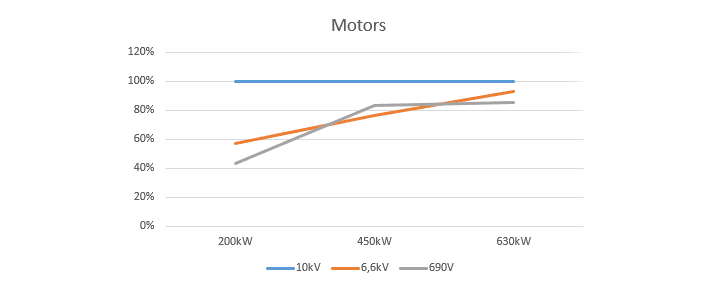This post is part of the motor management series discussing various aspects of motor integration in electrical networks and industrial processes. It presents a new chapter of the discussion with a case study for a conveyor application, composed of five VSD-controlled 630kW motors in 10kV versus 690V.
The motors are part of a large mining site and are connected in a remote area supplied with 10kV cable. The initial design for the 5 motors is a 10.5kV delivery by a 6.3MVA step-up transformer. This design relates to a conventional sizing practice where all motors are considered to operate simultaneously with 150% overload. After analyzing the operating mode, it turns out that one motor was a spare and the four remaining motors operate in pairs but not simultaneously. Therefore, the maximum loading is with two motors loaded at 150%, two others operating at rated load, and one motor as spare. In these conditions, the transformer can be sized down at 3.15MVA-AN / 4MVA-AF. These values are compatible with LV ratings and therefore the question of cost-effective voltage selection is raised. To make a recommendation, the different components of the power system need to be compared.
Let’s consider the motor cost evolution for three voltage values: 0.69, 6.6 and 10kV.

As shown on Figure 1, the 10kV motor holds the highest price in the considered power range. Therefore, the 690V and 6.6kV solutions seem interesting to check. Moreover, when the motors are near the supply switchgear, the 690V can be the best solution in terms of cost and footprint.
At 690V the following diagram can be proposed as alternative:

The proposed variant in LV does not contain any difference to the MV variant. It is important to notice that, for power quality compliance, the LV design contains low harmonic drives in order to avoid harmonic pollution and heating in the transformer. Analyses of the cost, footprint, reliability and start of these motors show high economical interest of this proposal, completed with important overall equipment footprint reduction. As a potential drawback, this solution will be more impacted by the additional cost of the cable length if cables appear longer in the final design.
With preliminary information, the maximum length is 150m for all motors. Table 1 gives the details of cost comparison with reference to the original design at 10kV:

It can be seen on this table that the cost of the cable increases highly in 690V and if the distance of the motors to MLVB are higher the cost reduction of the motor is not significant to compensate. If the length is 550m for the connection of motors, the cost is the same in 10kV and 690V. For more information, read the blog post LV/MV for large pumps dilemma.
The other interesting aspect of the comparison is the footprint. It is significantly reduced with low voltage equipment and by consequence the cost savings on the building is attractive. The footprint decrease is 66% for the LV switchgear and 88% for the VSD, as illustrated in Figure 3:

The difference is significant, and the size of the electrical building is reduced by 80% in low voltage.
In summary, the most important criteria for voltage optimization is the sizing of the supply transformer, in particular to permit a low voltage proposal, and the cable length of the motors to switchboard. If the length is lower than 150m the 690V is a better choice compared to 10kV. Sometimes lowering the voltage to 6.6kV can be a good choice due to the advantageous price of the motors and cables. In this case study, 690V is the best voltage in terms of footprint and cost. This is possible as the long cable connection is made at 10kV and the switchgear / VSD / transformer are near the motors.
Learn more about motor management on our website, or check out our other articles and white papers on this topic:
- LV or MV for large pumps and motor management in mining
- Solving the LV vs MV dilemma when optimizing costs for motor management
- Large Motor Starting 101: Discover the Constraints
- Large Motor starting 102: Motor applications and their characteristics – for a better motor management
- How the right motor management saves +20% OPEX in LNG ships
- High Power Motor Management Panorama




Conversation
Interesting document. However, the cable cost should not be reintegrated into the total cost in order to make the comparison more accurate. Another point is the transformer: I understand it would not be necessary for the MV solution, however, it would mandatory and contributes to the cost sum up and footprint in the LV solution.
Well done Avelino! This helps me understand why Mining Ehouse size can vary up to 80% for the same need!!